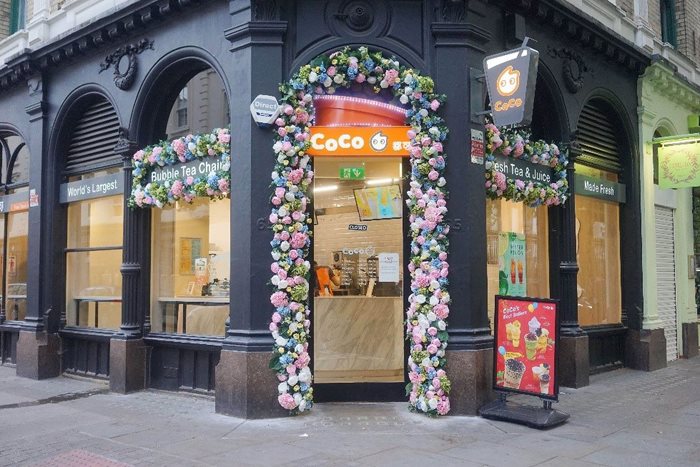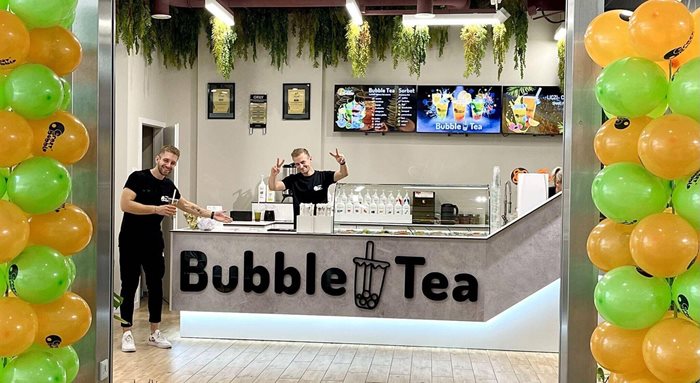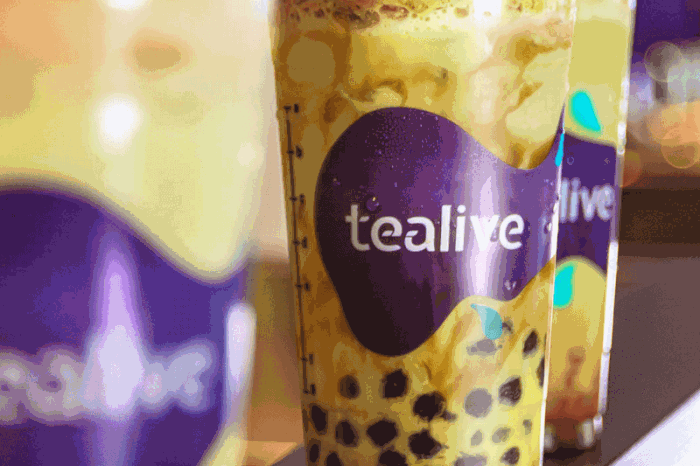As many western coffee chains look eastward for growth, Asia’s bubble tea giants are nurturing new audiences in North America and Europe. World Coffee Portal finds out how this colourful beverage is shaking up branded café markets in the US and Europe
.png.aspx?lang=en-GB&width=700&height=394)
Photo credit: Nicholas Ismael Martinez
From matcha to lychee, dragonfruit and even crème brûlée, bubble tea menus are a cornucopia of colour and flavour – with chilli crab and cream cheese also some of the more outlandish varieties.
Also known as pearl milk tea or boba tea, bubble tea traditionally consists of milk, black tea, sugar syrup and tapioca balls – a starch extracted from the roots of the cassava plant. While bubble tea’s name is often attributed to the chewy dark pearls that punctuate the beverage, it more accurately refers to the bubbles produced from vigorous shaking during preparation.
Originating in Taiwan in the 1980s, bubble tea is widely considered the brainchild of Liu Han-Chieh and Lin Hsiu Hui, the respective owner and Product Development Manager of Chun Shui Tang tea room in Taichung. The former’s experiment with cold tea collided with the latter’s tapioca-based pudding and the rest, as they say, is history.
“Coffee and bubble tea target audiences are very different”
Bryan Loo, Founder, Tealive
Whether fact or froth, the resulting beverage quickly garnered popularity in the 1990s and became ubiquitous across Asia, particularly in China, Japan and Singapore. Bubble tea is now a worldwide phenomenon led by the exponential growth of global chains such as CoCo Fresh Tea & Juice, Chatime and Gong cha. With the global market value forecast by some estimates to reach $4bn by 2030, these operators and many more are finding new audiences in Europe and the US.
Shake and share
With such an enticing array of flavours, often colourfully presented in transparent cups, bubble tea lends itself to social media sharing, making it particularly popular among under-30s. The hashtags ‘bubbletea’ and ‘bobatea’ have been collectively posted nearly five million times on Instagram and viewed more than 8.6 billion times on TikTok.
“The visually appealing nature of bubble tea and sharing these experiences on social media has contributed to bubble tea’s popularity, making it a sought-after beverage,” says Kody Wang, Business Development Manager of the world’s largest bubble tea chain, CoCo Fresh Tea & Juice.
Founded in Taipei in 1997, CoCo Fresh Tea & Juice has evolved into a global bubble tea powerhouse with more than 5,000 stores across Asia, Australasia, North America and Europe.
A strong social media presence and marketable product portfolio is also a key consideration for Bryan Loo, CEO of Loob Holding and founder of Malaysia’s largest bubble tea brand, Tealive. “People share photos and videos of their colourful and aesthetically pleasing bubble tea creations on Instagram and TikTok, sparking interest and curiosity among their followers,” he says.
“We expect demand in North America will continue to grow”
Kody Wang, Business Development Director, CoCo Fresh Tea & Juice
Launched in 2017, Tealive has rapidly grown to over 800 outlets in its native market and operates a handful of stores across Australia, Brunei, Cambodia,
Canada, Myanmar, the UK and Vietnam. Alongside a strong social media presence, Tealive has also made headway with other digital sales channels, such as app-based pre-ordering, pick-up, drive-thru and delivery.
The global tea party
Facing growing competition in increasingly crowded bubble tea markets, such as Taiwan, China, Vietnam and Japan, many operators are seeking new audiences beyond their traditional heartlands. For Tealive, international growth has been ‘opportunistic’. The company is currently focusing on expansion in Southeast Asia, particularly the Philippines, while it waits for the right time for a big North American push.
“We’re particularly excited by our corporate plan for the Filipino market and we have been rapidly expanding in Manila and Cebu. Our growth in the Philippines has been fast-tracked,” Loo says.

A CoCo Fresh Tea & Juice store in London, UK | Photo credit: CoCo Fresh Tea & Juice
However, CoCo Fresh Tea & Juice’s Wang believes there are already opportunities aplenty in the west. In the US, where the chain operates 35 stores, large Southeast Asian diasporas have enabled the brand to flourish in cosmopolitan urban centres, such as New York, which has the largest Chinese American population in the US.
Having established a presence and loyal customer bases in areas such as Manhattan’s Chinatown, CoCo Fresh Tea & Juice now has 17 stores in New York, including sites in the culturally diverse neighbourhoods of Jackson Heights and Flushing.
“The concrete Asia customer base in foreign markets has led to the quicker establishment of brand awareness locally,” says Wang.
CoCo Fresh Tea & Juice has deployed a similar formula in Canada. Sixty-one of its 100 stores are in Toronto, where Filipino and Chinese immigrants make up the largest proportion of Toronto’s non-native residents, according to the 2021 government census.
“We expect demand in North America will continue to grow, while at the same time competition is fierce,” Wang adds.
That competition currently comes from scaled international brands Gong cha, Happy Lemon and Tiger Sugar, as well as California-based Boba Guys and the self-proclaimed ‘OGs’ of American bubble tea, Kung Fu Tea – a 400-store chain that even started ‘National Bubble Tea Day’ – marked annually in the US on 30 April.
In comparison to Asia and to a lesser extent North America, the European bubble tea market is relatively nascent. However, valued above $300m and increasing 9% per year, the continent’s allure as a burgeoning bubble tea market is clear.
Highlighting this growth potential, Gong cha entered the
Belgian and
Portuguese markets in the last 12 months and has committed to
opening 200 stores in France by 2033 following its Paris debut in June 2023.
Gong cha CEO Paul Reynish recently outlined an ambitious goal of opening
500 stores in the UK, where it currently has 13 sites, highlighting opportunities in a coffee shop market he described as ‘saturated’.
Like New York, London is one of the most culturally diverse cities in the world, with large communities from across Southeast Asia. In August 2023, Chinese tea chain
Heytea made its European debut in London’s Chinatown, joining more than 25 branded bubble tea chains in the high footfall tourist enclave of Soho.
“The European bubble tea market has grown a lot, especially after Covid-19”
Jakub Woźniczka, Franchise Manager, Crazy Bubble
CoCo Fresh Tea & Juice has operated in Europe since 2019 and currently operates 15 outlets across six markets. The chain has opened stores in Stockholm, Rotterdam and Madrid over the last 12 months and is set to launch in Milan and Lyon before the end of 2023. “The brand has witnessed prominent growth in demand for bubble tea in Europe. The positive feedback from consumers gives us confidence to develop further in Europe,” says Wang.

Poland’s Crazy Bubble is Europe’s largest bubble tea chain, with 170 stores | Photo credit: Crazy Bubble
Inspired by Taiwanese bubble tea culture, Poland’s home-grown Crazy Bubble is Europe’s largest bubble tea chain and operates more than 175 stores across Poland, Lithuania, Romania, Montenegro, Estonia and Finland.
Having launched in 2012, when European consumers still approached bubble tea with a “dose of timidity,” Franchise Manager Jakub Woźniczka says the business has rapidly expanded to meet surging demand.
“The European bubble tea market has grown a lot, especially after Covid-19. We have opened about 100 outlets in the last two years alone,” he says.
With European consumers becoming increasingly familiar with bubble tea, Crazy Bubble entered Finland, its sixth European market, in September 2023 and is currently seeking new franchise partners across the continent.
“We want to maintain our status as the largest bubble tea franchise brand in Europe and plan to have Crazy Bubble in most European countries within the next five years, potentially even outside of Europe,” Woźniczka adds.
Are coffee shops missing a drink?
With demand for bubble tea seemingly at an all-time high, could coffee shops harness more opportunities from the segment?
“It is not just a matter of selling bubble tea – coffee and bubble tea target audiences are very different. One is looking out for functional fulfilment and the other is looking for fun. Both require a different set of strategies to win customer loyalty,” says Tealive’s Loo.
Not that some of the world’s largest coffee chains haven’t had a pop at bubble tea. Starbucks trialled its own iced coffee-based bubble beverages at US stores in California and Washington in January 2022 but has yet to announce a wider launch. Meanwhile, McDonald’s Hong Kong has served bubble tea on its summer menu since 2020. However, coffee and fast-food brands are yet to produce an authentic bubble tea product, says Kody Wang.
“The preparation requirements and know-how are not easily replicated and an enormous change in operations would be needed for them to make quality bubble tea products,” he says.
Nevertheless, Europe’s largest coffee chain, Costa Coffee, introduced bubble tea and bubble frappé ranges to the UK market in May 2023. Additionally, boutique café group EL&N is deploying vibrant green matcha and purple ube to complement its claim as the ‘world’s most Instagrammable café’.

Tealive bubble tea cups | Photo credit: Tealive
When coffee and tea collide
Alongside catering to new audiences in North America and Europe, fierce competition in Asia is driving bubble tea chains to continuously reinvent their already extensive menus, with the inclusion of coffee gaining traction.
“While bubble tea is up-and-coming in western markets, coffee has been developing rapidly in the east. We will continue to develop innovative coffee products through our R&D team,” says Wang, referring to Coco Fresh Tea & Juice’s bubble tea and coffee range, which includes salty cream coffee, mocha coffee and matcha coffee with pearls.
Earlier this year Tealive also introduced its revamped ‘Coffee by Tealive’ menu to promote new coffee-based creations, while Crazy Bubble offers hot and cold coffee customisation options across its bubble tea menu.
Although direct competition with coffee chains is unlikely in the near term, bubble tea brands are gaining market share in the US and Europe.
If established café operators such as Costa Coffee and EL&N make a splash with their bubble ranges, more branded coffee chains could follow suit by expanding existing cold and iced beverage menus. Having burst onto the scene in the US and Europe, bubble tea’s global sphere of influence looks set to grow.
This article was first published in Issue 16 of 5THWAVE magazine.
Subscribe to 5THWAVE to receive each edition in print and digitally or sign up to our newsletter and be the first to read the latest articles and updates on World Coffee Portal research.
